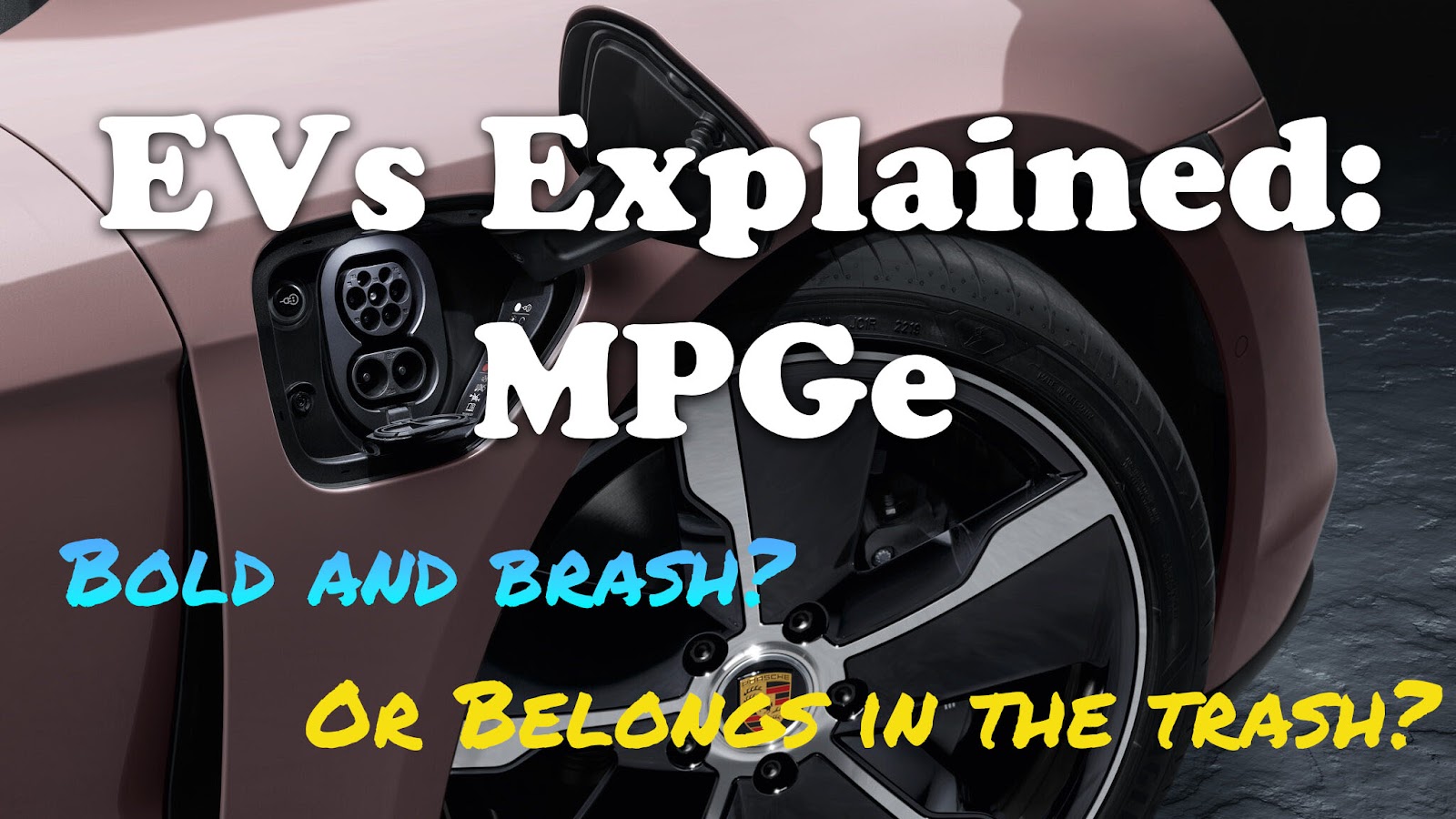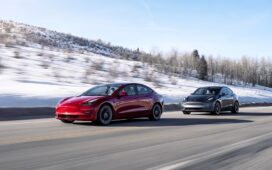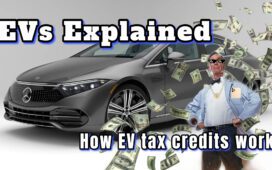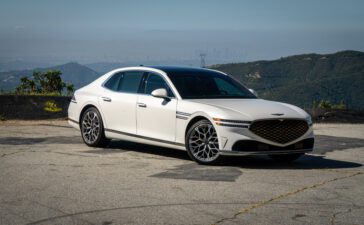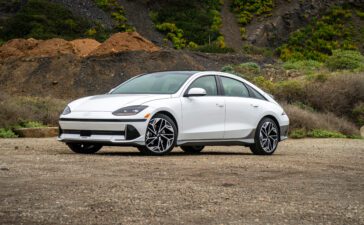Take your seats because we have yet another piece of electric car jargon to decipher. This next one seems easy enough, right? MPGe is just another measure of efficiency to coincide with this new wave of alternative powertrains and electrified driving machines. Apples to apples, or so you’d think. In reality, MPGe is kind of a head-scratcher. Buckle up and get ready to hypermile through this course because today we’re answering the question: What is MPGe in electric cars, and does it matter?
With this lesson, we hope to better understand how we tally EV efficiency and if this figure has any meaning left sailing the sea of stats.
A starting explanation
Coined by the EPA in late 2010 for the first-generation Nissan Leaf, MPGe is the newfound measurement for efficiency in alternative powertrains, intended to be viewed as the go-to standard like traditional miles per gallon. In fact, MPGe stands for – you guessed it – miles per gallon-equivalent. How creative. You can truly read the whimsy in my voice right now.

No, it’s not miles per gallon electric or miles per gallon even-though-it-ain’t-got-no-gas-innit.
Note that the term is equivalent and not electric, as the EPA uses it for a broad spectrum of powertrains, from plug-ins to hydrogen fuel cells. As such, cars like the Prius Prime and Toyota Mirai, while wildly different approaches, both measure with MPGe. However, the Prius Prime also measures fuel efficiency in standard miles per gallon for regular hybrid operation.
Akin to their fossil fuel counterpart, MPGe also comes in city, highway, and combined flavors. For instance, the Mirai ranks at 76 MPGe city and 71 highway, while the current-generation Nissan Leaf with a 40-kWh battery can achieve 123 MPGe city and 99 highway. The Prius Prime can measure as high as 133 MPGe in full EV mode. Not bad! On the other hand, a Hummer EV can only stretch to a meager 51 MPGe. Okay, pretty bad.

How is MPGe calculated?
To calculate MPGe, the EPA measures how much electricity is equivalent to the energy in one gallon of gasoline, which is roughly 34 kWh. Sources vary from 33.7 kWh to just a tick over 34 kWh, but let’s just round it to a nice, even 34 kWh. Then you take that gallon of gasoline-equivalent and compare that with the total miles covered.
The Wikipedia article on this subject has a unique formula drafted for visual learners, plus a chart to help calculate the MPGe of other fuel sources.
If, say, an EV achieved 50 miles of range on that roughly-34-kWh reserve, that’d be equal to 50 MPGe since it’d take a gallon of gasoline to cover the same distance. If the vehicle travels 80 miles off that same energy reserve, that’d be 80 MPGe, or 100 MPGe if it did 100 miles.

As you can imagine, vehicles with lower numbers are less efficient than rivals with higher ratings. Their MPGe figure is the star highlight of their energy efficiency, denoting how far they can travel on a certain amount of juice. It’s no different than miles per gallon with cars in this sense, except the numbers will often be far higher as electric powertrains are leaps and bounds more efficient than internal combustion engines due to them not suffering as much heat or friction losses.
Don’t be so taken aback by frequently seeing figures deep in the hundreds. Eliminate these losses in your gas-powered car, and you’ll probably see 80 miles per gallon all day.
Does MPGe actually matter, or is it a waste of our time?
Uh. Yes. And also kinda-sorta, yes.
Despite its intended role, many folks remain unconvinced of its usefulness. The same seems to be true with manufacturers, as you have to dig through a page or two before you land on their MPGe figures. Even Google doesn’t immediately list MPGe as a primary stat for many prominent EVs.
That’s not entirely the EPA’s fault, as all it did was craft a somewhat relatable measurement to help potential buyers decipher this new wave of high-voltage transportation. However, one disadvantage MPGe has that its fossil fuel counterpart doesn’t is an inconsistent and unreliable ability to determine how much most EV owners can expect to pay at the pump.
Oh, sorry. Plug.

Okay, so why is its usefulness kinda wishy-washy?
To quote the Car and Driver research staff: “You don’t have the luxury of that big sign at the gas station like you do when you fill-up the tank for a traditional combustion engine model, so how does that translate into electric costs?”
This impracticality partly stems from how wildly varying the costs of charging can be, from wall charging at home to fast charging on the go. Brands of chargers can also vary in cost, and even stations under the same corporate umbrella can fluctuate depending on location and how they charge for electrons. Some public stations may charge by the minute, while others go by the kilowatt-hour, with prices fluctuating nearly as much if not more than gasoline. Or, maybe you’re one of the few lucky Tesla owners I’ve met who’ve scored free charging access as part of the deal.
The other part also stems from the fact that MPGe is merely a newcomer stat that hasn’t quite settled into the minds of most buyers. What are we to do with ratings constantly in the 70s, 80s, or even higher? By that sense, we’d think Rivians and Hummers are poster children of eco-friendliness and electric car mileage – they’re totally not. And it doesn’t help that MPGe hardly gets any attention since the big ticket figures are always as follows: range first and foremost, and the battery pack’s kilowatt-hours a distant second. I can’t remember the last car review video I watched where they actually mentioned MPGe when these numbers were more readily available.
So what is MPGe best used for and can it be better?
So no, it’s not entirely useful as a multi-talented metric to determine overall ownership costs. At least not as easily. But it’s still damn good at its bare basic task: being a Top Trumps card on the showroom floor. In an age where it’s easy to get jumbled up with all the jargon out there, keeping it simple with MPGe and using it as a cross-shopping tool, just like traditional miles per gallon, is the best way to use it.

Neat! So these two EVs both rock 100 kWh batteries, but one gets 90 MPGe versus its rival’s 80? Winner! Compare and contrast, folks. Of course, don’t forget to take in things such as the kilowatt-hours of the battery pack, as that’s akin to the tank capacity of an ICE-powered car.
For those looking to simplify even further, there are promising solutions out there. As pointed out by fellow auto journo, Kevin Williams, why even bother doing the math to convert to gallons now that there’s a better understanding of kilowatts and kilowatt-hours out there? Williams proposed measuring in miles per kWh, eliminating a step in the formula, and aligning the efficiency stat with the kilowatt-hours we already use to measure battery energy.
But I guess that’s none of our business, EPA. I just write here.
Recap before recess
So remember, MPGe stands for miles per gallon-equivalent and is the unit of measurement for energy efficiency in alternative powertrain vehicles. For over a decade, it has been a common, if overlooked, data point for electrified cars. It bases its numbers on how far an EV can travel with the electric equivalent of a gallon of gas, approximately 34 kWh. However, unlike traditional miles per gallon, the roller coaster of price variations for charging hinders its usefulness in giving consumers a concrete dollar amount they can expect to pay. Even so, it proves competent for cross-comparisons and measuring how well EVs can use their electrons when stacked against their peers.

Pretty standard stuff, eh? Underwhelming, sure. But at least MPGe presents itself as an easy-to-grasp, easy-to-use metric as long as you treat it no differently from how you’d treat its traditional counterpart on the Monroney. Or you could say screw it in favor of total range and kilowatt-hours. Or you could pretend you never read any of this and keep going about your merry way. You’d be just fine either way with all the other data points out there to decide which EV is best for you. But never forget that EVs aren’t too dissimilar from gas burners in the sense that some cars are more miserly than others.
Because it’s nice to know a Polestar 2 makes far better use of its battery than that leviathan of a Hummer – for obvious reasons.

